北师大版(2019)必修 第三册Unit 9 Learning Writing Workshop课件(共32张)
文档属性
| 名称 | 北师大版(2019)必修 第三册Unit 9 Learning Writing Workshop课件(共32张) |
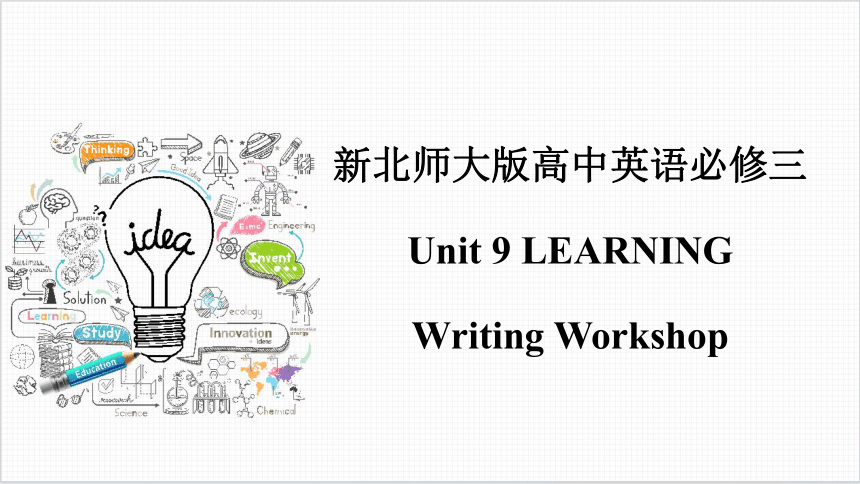
|
|
| 格式 | pptx | ||
| 文件大小 | 1.3MB | ||
| 资源类型 | 教案 | ||
| 版本资源 | 北师大版(2019) | ||
| 科目 | 英语 | ||
| 更新时间 | 2025-05-01 15:30:13 | ||
图片预览

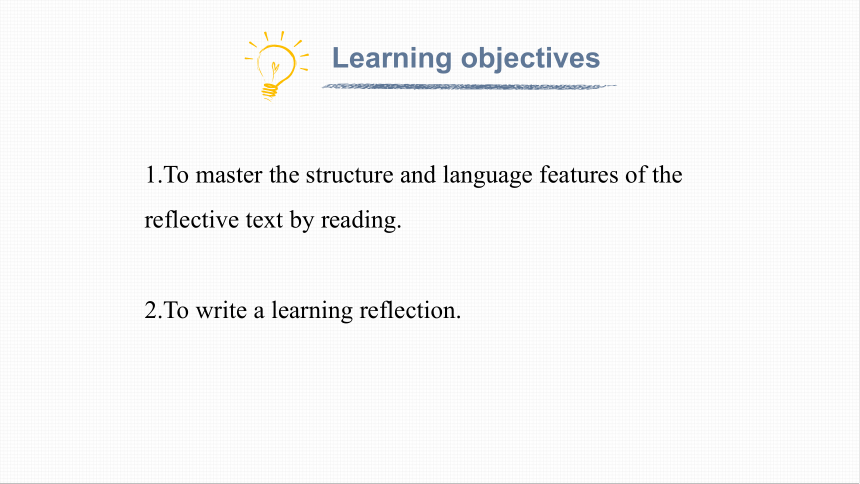
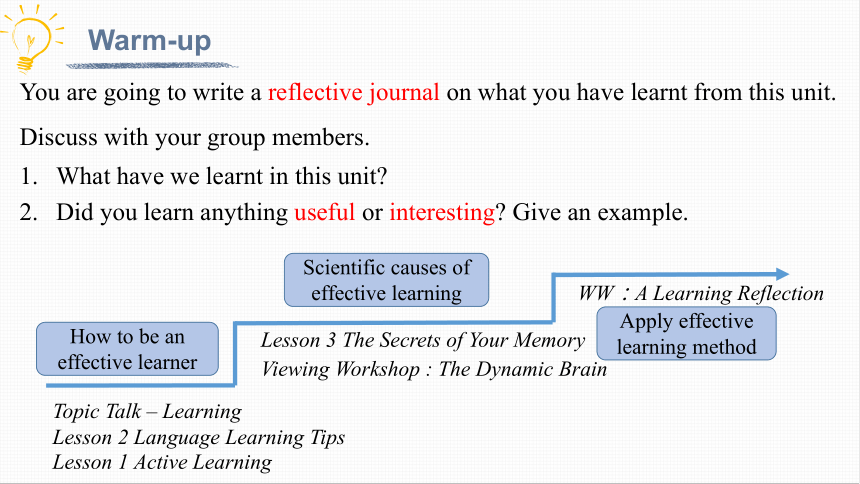


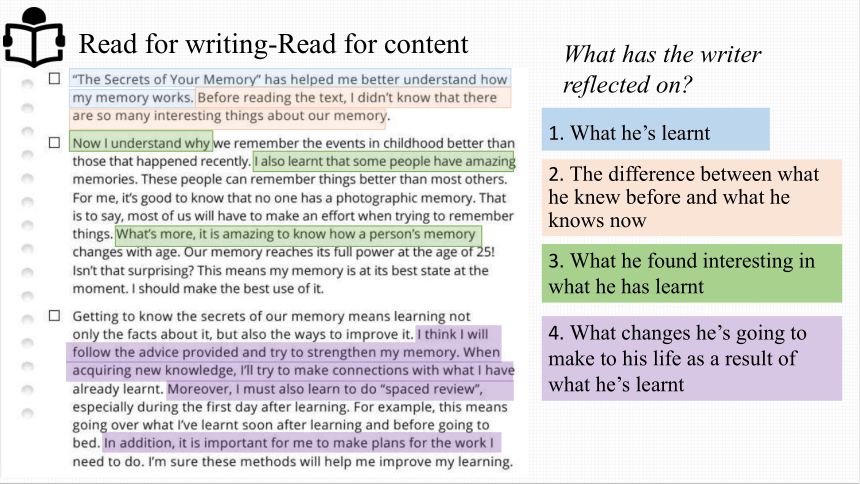
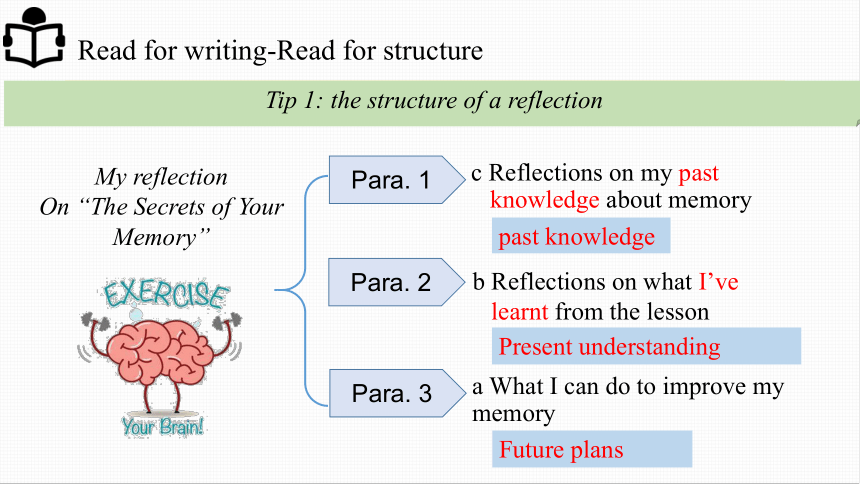

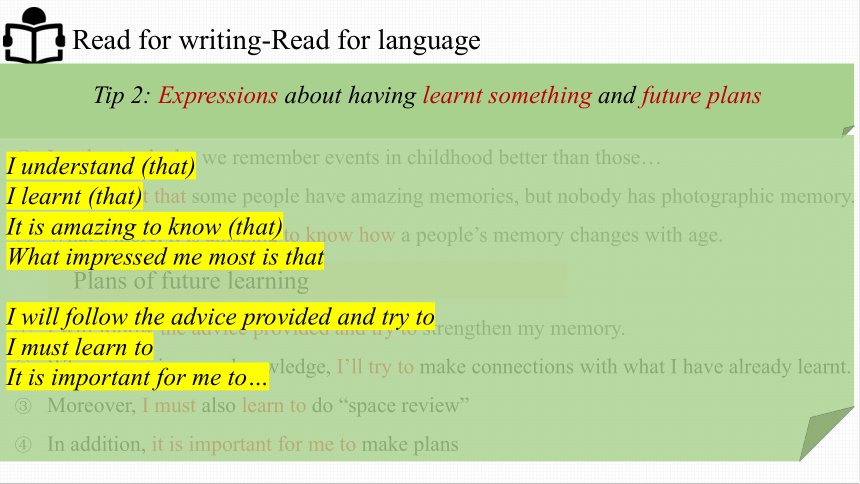
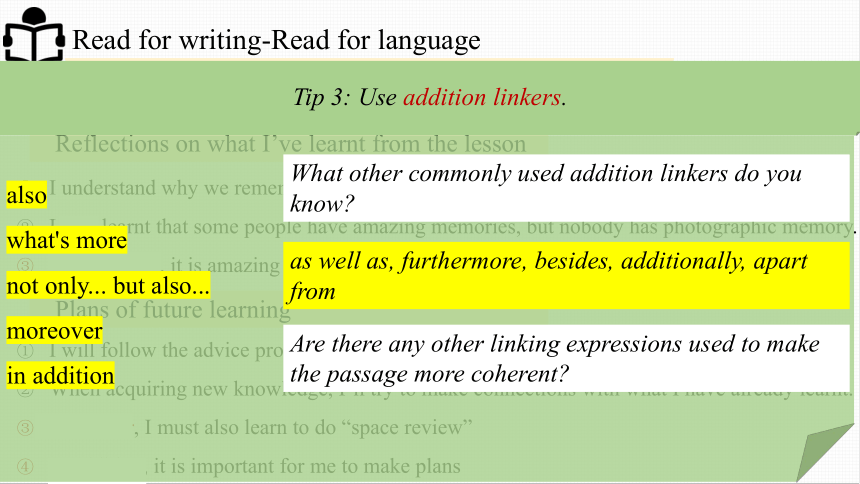
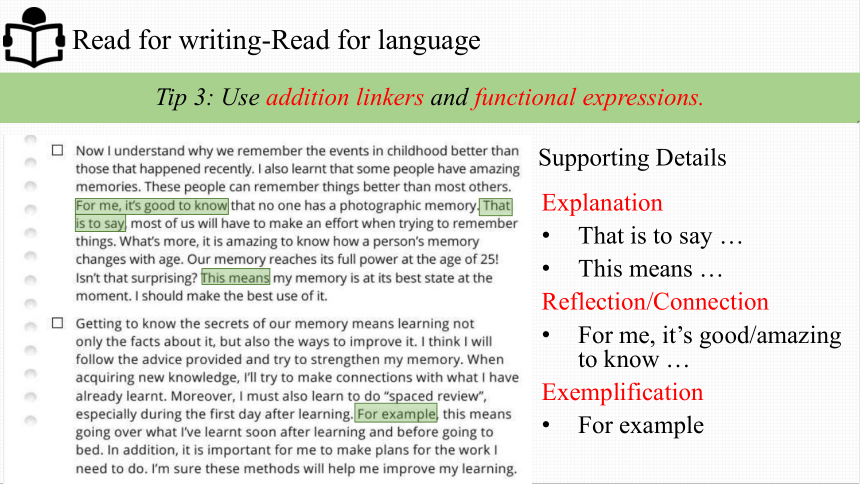

文档简介
(共32张PPT)
新北师大版高中英语必修三
Unit 9 LEARNING
Writing Workshop
1.To master the structure and language features of the reflective text by reading.
2.To write a learning reflection.
Learning objectives
You are going to write a reflective journal on what you have learnt from this unit. Discuss with your group members.
What have we learnt in this unit
Did you learn anything useful or interesting Give an example.
Topic Talk – Learning
Lesson 2 Language Learning Tips
Lesson 1 Active Learning
Lesson 3 The Secrets of Your Memory
Viewing Workshop : The Dynamic Brain
WW:A Learning Reflection
How to be an effective learner
Scientific causes of effective learning
Apply effective learning method
Warm-up
Lesson 2 Language Learning Tips
Lesson 1 Active Learning
Lesson 3 The Secrets of Your Memory
Things I can do to become an active learner
Listen to the outer voice
Argue with the inner voice
Get to the truth
Focus on the message
...
Tips to improve language learning
Read simplified classic works
Learn words in context
Use grammar in speaking and writing activities
Listen to English programs
...
Learning
Techniques to strengthen my memory
Retell what we have learnt to others
Focus on the ideas and be curious about what we learn
Review the materials periodically after learning
Make full use of our memory when we are young
...
Did you learn anything useful or interesting Give an example.
Warm-up
Read for writing-Read for ideas
My Reflection
On “The Secrets of Your Memory”
Read a reflective journal on “The Secrets of Your Memory”
List the things the writer has reflected on.
You can underline the things the writer has reflected on and circle any unfamiliar words.
What has the writer reflected on
Read for writing-Read for content
1. What he’s learnt
2. The difference between what he knew before and what he knows now
3. What he found interesting in what he has learnt
4. What changes he’s going to make to his life as a result of what he’s learnt
What has the writer reflected on
Read for writing-Read for structure
My reflection
On “The Secrets of Your Memory”
Para. 1
Para. 2
Para. 3
c Reflections on my past
knowledge about memory
b Reflections on what I’ve
learnt from the lesson
a What I can do to improve my memory
What does each paragraph talk about Summarize the main idea.
Present understanding
Future plans
past knowledge
Tip 1: the structure of a reflection
Read for writing-Read for language
I understand why we remember events in childhood better than those…
I also learnt that some people have amazing memories, but nobody has photographic memory.
What’s more, it is amazing to know how a people’s memory changes with age.
Reflections on what I’ve learnt from the lesson
What have the writer learnt and what will he do List the key points.
Plans of future learning
I will follow the advice provided and try to strengthen my memory.
When acquiring new knowledge, I’ll try to make connections with what I have already learnt.
Moreover, I must also learn to do “space review”
In addition, it is important for me to make plans
What sentence patterns are used to show his ideas of “having learnt something” and “future plans”
Read for writing-Read for language
I understand why we remember events in childhood better than those…
I also learnt that some people have amazing memories, but nobody has photographic memory.
What’s more, it is amazing to know how a people’s memory changes with age.
Plans of future learning
I will follow the advice provided and try to strengthen my memory.
When acquiring new knowledge, I’ll try to make connections with what I have already learnt.
Moreover, I must also learn to do “space review”
In addition, it is important for me to make plans
Reflections on what I’ve learnt from the lesson
Tip 2: Expressions about having learnt something and future plans
I understand (that)
I learnt (that)
It is amazing to know (that)
What impressed me most is that
I will follow the advice provided and try to
I must learn to
It is important for me to…
Read for writing-Read for language
I understand why we remember events in childhood better than those…
I also learnt that some people have amazing memories, but nobody has photographic memory.
What’s more, it is amazing to know how a people’s memory changes with age.
Plans of future learning
I will follow the advice provided and try to strengthen my memory.
When acquiring new knowledge, I’ll try to make connections with what I have already learnt.
Moreover, I must also learn to do “space review”
In addition, it is important for me to make plans
Reflections on what I’ve learnt from the lesson
How does the writer link the details together
Tip 3: Use addition linkers.
also
what's more
not only... but also...
moreover
in addition
What other commonly used addition linkers do you know
Are there any other linking expressions used to make the passage more coherent
as well as, furthermore, besides, additionally, apart from
Read for writing-Read for language
Tip 3: Use addition linkers.
Explanation
That is to say …
This means …
Reflection/Connection
For me, it’s good/amazing to know …
Exemplification
For example
Supporting Details
Tip 3: Use addition linkers and functional expressions.
How did the writer connect each paragraph
I didn’t know that there are so many interesting things about our memory.
Getting to know the secrets of our memory means learning not only the facts about it, but also the ways to improve it…
Read for writing-Read for language
Tip 4: Use transitional sentence to make the passage more coherent.
连接词
一个独立的句子反映一层相对独立的意思,由这些独立的句子组成的语篇虽然也能表达一定的含义。学会使用连接词是增加句子连贯的最主要的一个手段。
Warm-up
★ 表示附加信息的连接词
这类连接词有:and, also, again, too, as well as, in addition(另外,此外), besides, moreover (而且,此外), not only ... but also ..., furthermore (而且,此外), then等。
★ 表示转折和让步意义的连接词
这类连接词有:but, or, yet, on the contrary (相反), otherwise, however, even so, instead, while, although等。
★ 表示因果和目的的连接词
常用的表示因果和目的的连接词有:for, because, consequently (所以,因此), therefore, for this purpose, as a result等。
★ 表示例证和进一步解释的连接词
常见的连接词有:for example, as an example, in fact, for instance, such as, in other words, that is, namely, in general, especially, in particular等。
★ 表示时间和顺序的连接词
常见的连接词有:at the present time, sooner or later, at the same time, to begin with, since, later, when, after, then, before, meanwhile, during, eventually等。
★ 表示空间的连接词
常见的连接词有:here, there, where, beyond (在……较远的一边), inside, nearby, opposite to, to the left / right, in the middle, next to等。
★ 表示概括总结的连接词
常见的连接词有:in short, in conclusion, to sum up, in brief, on the whole等。
Write three important things that you have learnt in this unit. Use the Sentence Builder to help you.
______________________________________________________
______________________________________________________
______________________________________________________
Outlining Complete the outline of your reflection based on Activities 3 and 4.
My Outline
The topic I am going to reflect on:
___________________________
Paragraph 1: ________________________
Paragraph 2: ________________________
Paragraph 3: ________________________
Drafting Use your outline and the Writing Help to write your first draft. Make sure that the sentences and paragraphs are properly linked.
Writing a Learning Reflection
It's important to:
understand why you should reflect on what you have learnt;
choose one topic that you want to reflect on;
list what you knew about the topic before learning it, and what you know about it now;
include how you will use your new skill/knowledge in the future.
Writing help
Editing Edit your learning reflection in pairs. Then share what you have written in class.
Does the writer tell the reader which topic he/she is reflecting on
Does the writer explain the changes he/she has made after acquiring the knowledge
Does the writer tell his/her plans on how to use the knowledge or skills
Does the writer organize the piece of writing well by using addition linkers
◆ Mark any spelling, punctuation or grammar errors.
◆ Mark any unclear expressions. Give suggestions if you can.
◆ Underline the expressions you like.
Comments:__________________________________________
1.gap n.(大的)差距,差额,差别;间隔;开口
【教材原句】In countries such as Estonia,Latvia,Lithuania and the Netherlands,the difference between boys and girls was most significant,where they found a 30% gap or more between the genders.
在爱沙尼亚、拉脱维亚、立陶宛和荷兰等国,男孩和女孩之间的差别最大,男女差距达30%或更多。
Language Points
【归纳拓展】
bridge the gap,close the gap,narrow the gap都可表示“消除或缩小差距”。
a growing/widening gap 不断加大的差距
a trade gap 贸易差额
an age gap 年龄差距
2.evidence n.证据,证明
【教材原句】While reading in all forms is certainly beneficial and should be encouraged,the low numbers of boys reading for enjoyment and their limited choices when they do,is evidence of an issue that needs to be addressed.
虽然所有形式的阅读肯定是有益的,并且应该加以鼓励,但是为了乐趣而阅读的男孩数量很少,而且他们的选择有限,表明了这是一个需要解决的问题。
【归纳拓展】
evident adj. 明显的
evidently adv. 明显地
3.expose v.使接触;使体验
【教材原句】Countries need to think about ways to inspire interest for boys in reading and ensure that they are exposed to a wide variety of different types of literature from a young age.
各国需要想办法激发男孩对阅读的兴趣,并确保他们从小就接触到各种各样的不同类型的文学作品。
【归纳拓展】
(1)expose...to... 把……暴露在……
be exposed to 接触;暴露于
(2)exposure n. 接触;体验;暴露;揭露
1.not only...but also...不仅……而且……
【教材原句】Getting to know the secrets of our memory means learning not only the facts about it,but also the ways to improve it.
了解我们记忆的秘密意味着不仅要了解有关它的事实,还要了解提升它的方法。
【归纳拓展】
在本句中,not only...but also...连接learn的两个并列宾语。not only... but also...连接两个并列的主语时,谓语动词的单复数形式采取“就近一致”原则。
not only放在句首,后接句子时要用倒装结构,但but (also)后的句子不倒装。
单句语法填空
(1)Not only Tom but also his parents (be) invited the other day.
(2)Not only his parents but also Tom (be) invited the other day.
完成句子
(3)在教学中使用了电脑。结果不仅节省了老师的精力,也使学生对课堂更感兴趣。
The computer was used in teaching.As a result,not only
,but students became more interested in the lessons.
were
was
did teachers save energy
2.It is/was+adj./n.+for sb+to do sth.
【教材原句】In addition,it is important for me to make plans for the work I need to do.
此外,对我来说,为我需要做的工作做计划是很重要的。
【归纳拓展】
本句为简单句,其中it is important for me to make...属于“It is/was+adj./n.+for sb+to do sth.”句型,其中it是形式主语,真正的主语是后面的动词不定式短语。
(1)此句型中,“for sb”表示“对于某人来说”。注意be后面一定是描写事物性质的形容词。例如important,necessary,difficult,easy,hard,dangerous,safe,useful,pleasant,interesting,impossible,right,convenient等。
(2)It is/was+adj.+of sb+to do sth表示“某人做某事真是太……”。此句型中的形容词一定是描述人的品质的。例如good,kind,nice,polite,clever,foolish,stupid,lazy,careful,careless,brave,cruel,honest,naughty,rude等。
单句语法填空
(1)It is courageous him to speak out the truth.
(2)It’s standard practice for a company like this one (employ) a security officer.
(3)It is honour for the poor couple (invite) to the wedding.
(4)It is struggle for many girls to learn physics well.
(5) is bad manners for people to shout at others.
(6)It was a privilege ancient people to receive education.
(7)It is beneficial middle school students to participate in voluntary work.
of
to employ
an
to be invited
a
It
for
for
3.with复合结构
【教材原句】In places like Japan,boys and girls read for enjoyment at an almost identical level,with 54% of boys and 58% of girls reporting that they enjoy reading.
在日本这样的地方,男孩和女孩为了乐趣而阅读几乎在相同的水平上,54%的男孩和58%的女孩说他们喜欢阅读。
【归纳拓展】
本句为简单句,其中with 54% of boys and 58% of girls reporting that they enjoy reading为with复合结构,其中动词-ing形式作宾语补足语。
在with复合结构中,不同形式的宾语补足语的用法不同。具体如下:
(1)动词-ing形式作宾语补足语表示动作正在进行,和宾语之间是逻辑上的主谓关系。
(2)过去分词作宾语补足语表示动作已经完成,和宾语之间是逻辑上的动宾关系。
(3)动词不定式作宾语补足语表示动作暂时没有发生,有将来的含义。
(4)形容词、副词、介词短语作宾语补足语表示宾语的特征或性质。
单句语法填空
(1)With nothing (do),he went out for a walk.
(2)With his hair (cut),he looked much younger.
(3)With the fire (spread),many people had to leave their homes.
(4)The old couple often take a walk after supper in the park with their pet dog
(follow) them.
(5)With his work (finish),he went home happily.
(6)I can’t concentrate on my study all the noise going on.
(7)The teacher entered the classroom,with a book his hand.
to do
cut
spreading
following
finished
with
in
新北师大版高中英语必修三
Unit 9 LEARNING
Writing Workshop
1.To master the structure and language features of the reflective text by reading.
2.To write a learning reflection.
Learning objectives
You are going to write a reflective journal on what you have learnt from this unit. Discuss with your group members.
What have we learnt in this unit
Did you learn anything useful or interesting Give an example.
Topic Talk – Learning
Lesson 2 Language Learning Tips
Lesson 1 Active Learning
Lesson 3 The Secrets of Your Memory
Viewing Workshop : The Dynamic Brain
WW:A Learning Reflection
How to be an effective learner
Scientific causes of effective learning
Apply effective learning method
Warm-up
Lesson 2 Language Learning Tips
Lesson 1 Active Learning
Lesson 3 The Secrets of Your Memory
Things I can do to become an active learner
Listen to the outer voice
Argue with the inner voice
Get to the truth
Focus on the message
...
Tips to improve language learning
Read simplified classic works
Learn words in context
Use grammar in speaking and writing activities
Listen to English programs
...
Learning
Techniques to strengthen my memory
Retell what we have learnt to others
Focus on the ideas and be curious about what we learn
Review the materials periodically after learning
Make full use of our memory when we are young
...
Did you learn anything useful or interesting Give an example.
Warm-up
Read for writing-Read for ideas
My Reflection
On “The Secrets of Your Memory”
Read a reflective journal on “The Secrets of Your Memory”
List the things the writer has reflected on.
You can underline the things the writer has reflected on and circle any unfamiliar words.
What has the writer reflected on
Read for writing-Read for content
1. What he’s learnt
2. The difference between what he knew before and what he knows now
3. What he found interesting in what he has learnt
4. What changes he’s going to make to his life as a result of what he’s learnt
What has the writer reflected on
Read for writing-Read for structure
My reflection
On “The Secrets of Your Memory”
Para. 1
Para. 2
Para. 3
c Reflections on my past
knowledge about memory
b Reflections on what I’ve
learnt from the lesson
a What I can do to improve my memory
What does each paragraph talk about Summarize the main idea.
Present understanding
Future plans
past knowledge
Tip 1: the structure of a reflection
Read for writing-Read for language
I understand why we remember events in childhood better than those…
I also learnt that some people have amazing memories, but nobody has photographic memory.
What’s more, it is amazing to know how a people’s memory changes with age.
Reflections on what I’ve learnt from the lesson
What have the writer learnt and what will he do List the key points.
Plans of future learning
I will follow the advice provided and try to strengthen my memory.
When acquiring new knowledge, I’ll try to make connections with what I have already learnt.
Moreover, I must also learn to do “space review”
In addition, it is important for me to make plans
What sentence patterns are used to show his ideas of “having learnt something” and “future plans”
Read for writing-Read for language
I understand why we remember events in childhood better than those…
I also learnt that some people have amazing memories, but nobody has photographic memory.
What’s more, it is amazing to know how a people’s memory changes with age.
Plans of future learning
I will follow the advice provided and try to strengthen my memory.
When acquiring new knowledge, I’ll try to make connections with what I have already learnt.
Moreover, I must also learn to do “space review”
In addition, it is important for me to make plans
Reflections on what I’ve learnt from the lesson
Tip 2: Expressions about having learnt something and future plans
I understand (that)
I learnt (that)
It is amazing to know (that)
What impressed me most is that
I will follow the advice provided and try to
I must learn to
It is important for me to…
Read for writing-Read for language
I understand why we remember events in childhood better than those…
I also learnt that some people have amazing memories, but nobody has photographic memory.
What’s more, it is amazing to know how a people’s memory changes with age.
Plans of future learning
I will follow the advice provided and try to strengthen my memory.
When acquiring new knowledge, I’ll try to make connections with what I have already learnt.
Moreover, I must also learn to do “space review”
In addition, it is important for me to make plans
Reflections on what I’ve learnt from the lesson
How does the writer link the details together
Tip 3: Use addition linkers.
also
what's more
not only... but also...
moreover
in addition
What other commonly used addition linkers do you know
Are there any other linking expressions used to make the passage more coherent
as well as, furthermore, besides, additionally, apart from
Read for writing-Read for language
Tip 3: Use addition linkers.
Explanation
That is to say …
This means …
Reflection/Connection
For me, it’s good/amazing to know …
Exemplification
For example
Supporting Details
Tip 3: Use addition linkers and functional expressions.
How did the writer connect each paragraph
I didn’t know that there are so many interesting things about our memory.
Getting to know the secrets of our memory means learning not only the facts about it, but also the ways to improve it…
Read for writing-Read for language
Tip 4: Use transitional sentence to make the passage more coherent.
连接词
一个独立的句子反映一层相对独立的意思,由这些独立的句子组成的语篇虽然也能表达一定的含义。学会使用连接词是增加句子连贯的最主要的一个手段。
Warm-up
★ 表示附加信息的连接词
这类连接词有:and, also, again, too, as well as, in addition(另外,此外), besides, moreover (而且,此外), not only ... but also ..., furthermore (而且,此外), then等。
★ 表示转折和让步意义的连接词
这类连接词有:but, or, yet, on the contrary (相反), otherwise, however, even so, instead, while, although等。
★ 表示因果和目的的连接词
常用的表示因果和目的的连接词有:for, because, consequently (所以,因此), therefore, for this purpose, as a result等。
★ 表示例证和进一步解释的连接词
常见的连接词有:for example, as an example, in fact, for instance, such as, in other words, that is, namely, in general, especially, in particular等。
★ 表示时间和顺序的连接词
常见的连接词有:at the present time, sooner or later, at the same time, to begin with, since, later, when, after, then, before, meanwhile, during, eventually等。
★ 表示空间的连接词
常见的连接词有:here, there, where, beyond (在……较远的一边), inside, nearby, opposite to, to the left / right, in the middle, next to等。
★ 表示概括总结的连接词
常见的连接词有:in short, in conclusion, to sum up, in brief, on the whole等。
Write three important things that you have learnt in this unit. Use the Sentence Builder to help you.
______________________________________________________
______________________________________________________
______________________________________________________
Outlining Complete the outline of your reflection based on Activities 3 and 4.
My Outline
The topic I am going to reflect on:
___________________________
Paragraph 1: ________________________
Paragraph 2: ________________________
Paragraph 3: ________________________
Drafting Use your outline and the Writing Help to write your first draft. Make sure that the sentences and paragraphs are properly linked.
Writing a Learning Reflection
It's important to:
understand why you should reflect on what you have learnt;
choose one topic that you want to reflect on;
list what you knew about the topic before learning it, and what you know about it now;
include how you will use your new skill/knowledge in the future.
Writing help
Editing Edit your learning reflection in pairs. Then share what you have written in class.
Does the writer tell the reader which topic he/she is reflecting on
Does the writer explain the changes he/she has made after acquiring the knowledge
Does the writer tell his/her plans on how to use the knowledge or skills
Does the writer organize the piece of writing well by using addition linkers
◆ Mark any spelling, punctuation or grammar errors.
◆ Mark any unclear expressions. Give suggestions if you can.
◆ Underline the expressions you like.
Comments:__________________________________________
1.gap n.(大的)差距,差额,差别;间隔;开口
【教材原句】In countries such as Estonia,Latvia,Lithuania and the Netherlands,the difference between boys and girls was most significant,where they found a 30% gap or more between the genders.
在爱沙尼亚、拉脱维亚、立陶宛和荷兰等国,男孩和女孩之间的差别最大,男女差距达30%或更多。
Language Points
【归纳拓展】
bridge the gap,close the gap,narrow the gap都可表示“消除或缩小差距”。
a growing/widening gap 不断加大的差距
a trade gap 贸易差额
an age gap 年龄差距
2.evidence n.证据,证明
【教材原句】While reading in all forms is certainly beneficial and should be encouraged,the low numbers of boys reading for enjoyment and their limited choices when they do,is evidence of an issue that needs to be addressed.
虽然所有形式的阅读肯定是有益的,并且应该加以鼓励,但是为了乐趣而阅读的男孩数量很少,而且他们的选择有限,表明了这是一个需要解决的问题。
【归纳拓展】
evident adj. 明显的
evidently adv. 明显地
3.expose v.使接触;使体验
【教材原句】Countries need to think about ways to inspire interest for boys in reading and ensure that they are exposed to a wide variety of different types of literature from a young age.
各国需要想办法激发男孩对阅读的兴趣,并确保他们从小就接触到各种各样的不同类型的文学作品。
【归纳拓展】
(1)expose...to... 把……暴露在……
be exposed to 接触;暴露于
(2)exposure n. 接触;体验;暴露;揭露
1.not only...but also...不仅……而且……
【教材原句】Getting to know the secrets of our memory means learning not only the facts about it,but also the ways to improve it.
了解我们记忆的秘密意味着不仅要了解有关它的事实,还要了解提升它的方法。
【归纳拓展】
在本句中,not only...but also...连接learn的两个并列宾语。not only... but also...连接两个并列的主语时,谓语动词的单复数形式采取“就近一致”原则。
not only放在句首,后接句子时要用倒装结构,但but (also)后的句子不倒装。
单句语法填空
(1)Not only Tom but also his parents (be) invited the other day.
(2)Not only his parents but also Tom (be) invited the other day.
完成句子
(3)在教学中使用了电脑。结果不仅节省了老师的精力,也使学生对课堂更感兴趣。
The computer was used in teaching.As a result,not only
,but students became more interested in the lessons.
were
was
did teachers save energy
2.It is/was+adj./n.+for sb+to do sth.
【教材原句】In addition,it is important for me to make plans for the work I need to do.
此外,对我来说,为我需要做的工作做计划是很重要的。
【归纳拓展】
本句为简单句,其中it is important for me to make...属于“It is/was+adj./n.+for sb+to do sth.”句型,其中it是形式主语,真正的主语是后面的动词不定式短语。
(1)此句型中,“for sb”表示“对于某人来说”。注意be后面一定是描写事物性质的形容词。例如important,necessary,difficult,easy,hard,dangerous,safe,useful,pleasant,interesting,impossible,right,convenient等。
(2)It is/was+adj.+of sb+to do sth表示“某人做某事真是太……”。此句型中的形容词一定是描述人的品质的。例如good,kind,nice,polite,clever,foolish,stupid,lazy,careful,careless,brave,cruel,honest,naughty,rude等。
单句语法填空
(1)It is courageous him to speak out the truth.
(2)It’s standard practice for a company like this one (employ) a security officer.
(3)It is honour for the poor couple (invite) to the wedding.
(4)It is struggle for many girls to learn physics well.
(5) is bad manners for people to shout at others.
(6)It was a privilege ancient people to receive education.
(7)It is beneficial middle school students to participate in voluntary work.
of
to employ
an
to be invited
a
It
for
for
3.with复合结构
【教材原句】In places like Japan,boys and girls read for enjoyment at an almost identical level,with 54% of boys and 58% of girls reporting that they enjoy reading.
在日本这样的地方,男孩和女孩为了乐趣而阅读几乎在相同的水平上,54%的男孩和58%的女孩说他们喜欢阅读。
【归纳拓展】
本句为简单句,其中with 54% of boys and 58% of girls reporting that they enjoy reading为with复合结构,其中动词-ing形式作宾语补足语。
在with复合结构中,不同形式的宾语补足语的用法不同。具体如下:
(1)动词-ing形式作宾语补足语表示动作正在进行,和宾语之间是逻辑上的主谓关系。
(2)过去分词作宾语补足语表示动作已经完成,和宾语之间是逻辑上的动宾关系。
(3)动词不定式作宾语补足语表示动作暂时没有发生,有将来的含义。
(4)形容词、副词、介词短语作宾语补足语表示宾语的特征或性质。
单句语法填空
(1)With nothing (do),he went out for a walk.
(2)With his hair (cut),he looked much younger.
(3)With the fire (spread),many people had to leave their homes.
(4)The old couple often take a walk after supper in the park with their pet dog
(follow) them.
(5)With his work (finish),he went home happily.
(6)I can’t concentrate on my study all the noise going on.
(7)The teacher entered the classroom,with a book his hand.
to do
cut
spreading
following
finished
with
in
同课章节目录
- Unit 7 Art
- Lesson 1 Masterpieces
- Lesson 2 Beijing Opera
- Lesson 3 A Musical Genius
- Unit 8 Green living
- Lesson 1 Roots and Shoots
- Lesson 2 Greening the Desert
- Lesson 3 "White Bikes" on the Road
- Unit 9 Learning
- Lesson 1 Active Learning
- Lesson 2 Language Learning Tips
- Lesson 3 The Secrets of Your Memory
